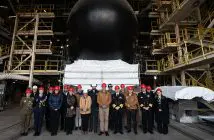
Written by staff writer.
Canberra-based space services company Skykraft is on the verge of revolutionizing air traffic management and communications services and demonstrating the global impact the Australian space sector can have.
Over the next two years, Skykraft is launching a 200-strong satellite constellation that will address gaps in surveillance and communications for aircraft travelling over remote and oceanic areas, including long-haul trans-Pacific flights.
The satellites will provide an air traffic surveillance system and a Very High Frequency (VHF) radio communication system. It will extend the reach of VHF to parts of the planet still covered by older technologies.
The first five satellites were deployed in January, hitching a ride on SpaceX’s Falcon 9 rocket. Weighing a collective 300 kilograms, it was the biggest Australian-made payload ever sent into space. When fully rolled out, the constellation will allow Australia to provide global air traffic management coverage for the first time.
It’s a significant result for six-year-old Skykraft, a spin-off from the University of New South Wales’ space capabilities incubator. Exhibiting at the recent Australian International Air Show at Avalon outside Melbourne, SkyKraft was also generating plenty of trade interest there.
“In Australia, we can do space, and we can do space well, and we can do big things in space,” said Michael Frater, Skykraft CEO. Skykraft’s satellites are fully programmable in orbit, enabling rapid prototyping and the development of new services after launch. They say the space-based air traffic management service will increase the efficiency of aviation worldwide.
“It means that a plane in the middle of the Pacific Ocean will get the same air traffic management service that it would get if it were close to a major airport,” said Frater. “This is good for air safety and reducing the environmental impact of travel.”
The satellites are manufactured in Canberra using suppliers from across Australia in what Skykraft calls a “resilient production process.” The company says it can provide air traffic management coverage at a commercially competitive price due to recent significant reductions in space access costs. A common platform means it can be easily integrated into existing aircraft and ground systems.
Since Avalon, Skykraft has signed a memorandum of understanding with Airways New Zealand, that country’s air navigation service provider that looks after 30 million square kilometres of airspace over the South Pacific, Tasman Sea, and Southern Ocean. Under the MOU, SkyKraft will test the data provided by its satellites already in orbit, which will be gathered and compared to the Airways New Zealand data.
“The memorandum of understanding allows us to work with Airways New Zealand, a world leader in air traffic management, on a proof-of-concept demonstration of Skykraft’s world-first combination of space-based air traffic surveillance and VHF radio communications,” said Skykraft’s Chairman, Air Vice-Marshal (Ret’d) Mark Skidmore.
Airways New Zealand says a satellite-based VHF radio communication system will create a “step-change for aviation.” Around 13 passenger and cargo airlines regularly fly between South Pacific and Australasian airports and the Americas while relying on previous-generation technologies to determine their location and maintain communications.
Skykraft has scheduled further satellite launches in mid-2023 and early 2024.





